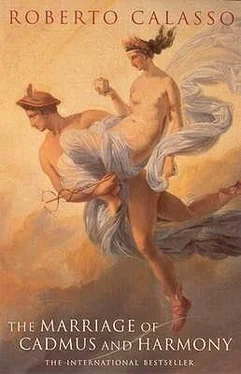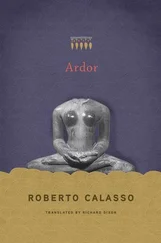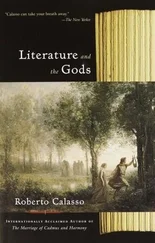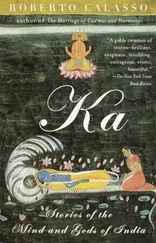
Climbing the spiral staircase inside the temple took you to the upper galleries, where you could get a closer view of Phidias’s Zeus. To Quintilianus’s mind, this statue had “added something to the religion of men.” Its gold and ivory surfaces were broken only by gems, except on the throne, which also had some ebony. The drapery was strewn with animals and lilies. Zeus wore a crown of olive twigs and in his right hand held a Nike, goddess of victory, with a ribbon and a crown. Beneath each of the throne’s four feet were other small Nikes, like dancing elves. But something else was going on among those feet: winged Sphinxes carried off Theban youths in their claws, and Apollo and Artemis loosed their arrows at Niobe’s children again. And as it grew accustomed to the teeming dark, the eye would make out one new scene after another, sculpted on the cross-struts of the throne. The farther down you looked, the more figures you saw. Twenty-nine in all on the cross-struts: the Amazons, Heracles with his escort, Theseus. A boy is adjusting a ribbon on his forehead: is it Pantarckes, Phidias’s young lover? You can’t go right up to the throne, because of the painted barriers, which again show Theseus and Heracles, and then Peirithous, Ajax, Cassandra, Hippodamia, Sterope, Prometheus, Penthesilea, Achilles, two Hesperides. Other beings sprout from the top of the throne: three Charites and three Hours. Then the eye moves back down to Zeus’s footstool and finds still more figures: Theseus yet again, and again the Amazons and golden lions. As one looks down even farther, at the base that supports the huge Zeus and his parasites, other scenes become apparent: Helios climbs onto his chariot, Hermes advances as Hestia follows, Eros greets Aphrodite as she rises from the waves and Peitho crowns her. Nor has the sculptor forgotten Apollo and Artemis, Athena and Heracles, Amphitryon and Poseidon, and Selene on a horse. A seated giant encrusted with creatures, Zeus was reflected in a floor of shiny black stone where oil flowed in abundance to preserve the ivory.
No other statue was so admired by the Greeks, nor even by Zeus himself, who hurled an approving thunderbolt down on the black paving when Phidias finished the job and asked the god for a sign. Olympia’s chryselephantine Zeus was destroyed in a palace fire in Byzantium in the fifth century. All that remains are some Elean coins showing the statue, and the words of those who, like Callimachus and Pausanias, saw it and were impressed. Paulus Aemilius claimed that Phidias had given form to Homer’s Zeus.
The moderns have been cowed and confused by these descriptions. Too many colors, too much Oriental pomp, the suspicion of a lapse of taste. Could Phidias, they wonder, in this, his most ambitious project, have tossed aside all the qualities so admired in the Parthenon friezes? The mistake of the moderns is to think of Phidias’s Zeus as a statue, in the sense in which Praxiteles’ Hermes is a statue. For it was something else. Shut away and sparkling in its temple cell, Phidias’s Zeus was closer to a dolmen, a bethel, a stone fallen from heaven, to which other gods and heroes clung in order to live. The gold and ivory seethed like an ants’ nest. Zeus didn’t exist except as a support for animals and lilies, arches and drapes, old scenes forever repeated. But Zeus was more than just the motionless guardian seated on his throne: Zeus was all those scenes, those deeds, muddled and shuffled about, rippling his body and throne in tiny shivers. Without meaning to, Phidias had illustrated that Zeus cannot live alone: without meaning to, he had represented the essence of polytheism.
Olympia was happiness itself for the Greeks, who were experts in unhappiness. The dense green in the Peloponnese has a hallucinatory glow to it, a glow the more intense for being so rare, with something final about it. All the different species of green gather around Olympia, as once the athletes of every Greek-speaking settlement would come here to compete. The acid phosphorescence of the Aleppo pines, the darkly etched cypresses, the glassy streaked leaves of the lemon trees, the primordial bamboo — see them all against a background of gently contoured hills modeled by Poseidon’s thumb, the earthquake. The place was the gift of a man who became a river, Alpheus. Having forced a path between the bare, scorching peaks of Arcadia, having washed the slopes of Lykaion — mountain of wolves and cannibals on whose summit the sun casts never a shadow — the Alpheus finally astonishes when, emerging from the gorges of Cerynite, it broadens into the rolling slopes of a valley as dear to Zeus as the archaic Lykaion had once been hateful. The Greeks were not in the habit of mentioning nature to no end, but Pausanias extols the Alpheus on three separate occasions: “the greatest of rivers for the volume of water passing through it, and the most pleasing to the eye”; a river “legendary to lovers,” thanks to its origin; and finally, to Zeus’s mind, “the most exquisite of all rivers.”
But who was Alpheus? A hunter. He saw the goddess-huntress Artemis, fell in love with her, and with vain mortal brashness began to follow her. All over Greece, the goddess heard those footsteps behind her and laughed. One night, in Letrinoi, not far from Olympia, she decided to celebrate a feast with her Nymphs. Before Alpheus caught up with them, goddess and Nymphs smeared their faces with clay. Alpheus saw whitish faces looming in the dark. Which was the goddess? He couldn’t say. So the hunter who had “mustered up the courage to attempt to rape” the goddess was forced to give up and “went away without having achieved his goal,” his ears smarting with the sound of shrill, mocking laughter. Yet never had Artemis, that most cruel of goddesses, been so kind to an admirer, nor would she be again. Instead of having him torn to pieces by his dogs, like Actaeon, who hadn’t even come near her, she let Alpheus walk off unharmed, and initiated. In Greek stories, smearing one’s face foreshadows a momentous and terrible event. The Titans smeared chalk on their faces before tearing Zagreus to pieces. But here, instead of being the prelude to carnage, the smearing serves to stave off the dire event. The virgin goddess avoids being abused precisely by making herself similar to her Nymphs. She does the opposite of what her initiates do: dress up and wear masks to look like the goddess. Artemis’s gesture dissolves an impending horror in laughter.
Alpheus encounters the goddess and her Nymphs as a group of people wearing masks, or dead. And it is difficult to get your bearings among the masked and the dead; even goddesses can no longer be recognized with confidence, because here one has crossed the threshold of another world. The laughter that rang in the retreating Alpheus’s ears was, for the goddess, the greatest possible token of affection, an act of kindness. After all, she had demonstrated to this rash and ignorant man the elusive and insurmountable distance between woman and goddess: and all it had taken was a bit of clay. The huntress-goddess escapes all the more irretrievably when disguised as a woman.
But Artemis wanted to protect the hunter. She couldn’t give him her body, so she chose a Nymph, Arethusa, as her substitute. And Alpheus began a second passionate chase. In the fury of flight, Arethusa crossed the sea and transformed herself into a freshwater spring near Syracuse. This time Alpheus could not renounce his love. The hunter became the river Alpheus, flowed out into the sea just before Pyrgos, and traveled, for hundreds of miles, right across the Ionian Sea as an underwater current. When he surfaced again with his frothy crown, he was in Sicily, near Arethusa. Where he mingled his own waters with the Nymph’s.
Читать дальше













